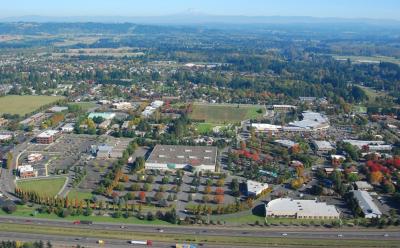2016 Community Survey
Findings from the recently completed National Citizen Survey™ (NCS) of Wilsonville were presented at the September 19 meeting of the Wilsonville City Council by Ashley Perez de Tejada, Survey Consultant for the National Research Center (NRC) based in Boulder, Colorado. The 2016 survey is the third statistically-valid questionnaire conducted for the community over the past six years, providing the opinions of a representative sample of 536 residents of Wilsonville. The local survey also compares current results with results from over 500 communities across the U.S as well as to past local surveys completed in 2014 and 2012.
The report finds, “In the case of Wilsonville, 93% rated the City as an excellent or good place to live.” The report continues, “About 9 in 10 respondents gave positive ratings to Wilsonville as a place to raise children and to the overall appearance of the City. These ratings were higher than the national benchmark, along with the rating for Wilsonville’s overall image (84% excellent or good).”
Mayor Tim Knapp states, “Overall these positive results indicate that our residents continue to enjoy Wilsonville as a high quality place to live and to raise their families. The survey results also point out that we all are challenged in working both locally and regionally to address growing concerns over traffic congestion, urban growth, and housing costs and availability."
2016 Key Findings Presentation
City Manager Bryan Cosgrove shares, “While we are pleased to see that a large majority of community members feel they are getting excellent or good customer service from the City, we also see from the survey results that there is still room for improvement in the future. In particular, the community expects more in the area of traffic congestion and growth concerns. We will make a concerted effort in the coming months to engage our residents on those two topics specifically.”
Other ratings that were higher than the national benchmark included: overall image, overall feeling of safety, paths and walking trails, ease of walking, travel by bicycle, travel by public transportation, overall natural environment, cleanliness, overall built environment, public places, place to work, K-12 education, street repair, street cleaning, sidewalk maintenance, bus or transit service, code enforcement, city parks and public libraries.
Other notable findings from the recent survey include:
- Eight in 10 respondents thought highly of the customer service provided by City employees.
- About six in 10 respondents gave excellent or good ratings to the overall direction of City government, the City welcoming citizen involvement, confidence in Wilsonville government and acting in the best interest of the community.
When asked “What do you think is the biggest priority facing the City of Wilsonville over the next five years,” 38% of respondents identified traffic, roads and transportation, 24% identified planning growth and expansion and 18% identified housing and affordability as a top priority.
Regarding healthy living, 69% of the respondents felt that improving sidewalks and bike lanes and 62% felt increasing recreational opportunities and programs are either very important or essential. The complete survey, along with open-ended responses from community members, is available at www.ci.wilsonville.or.us/CommunitySurvey.
Survey Background
The NCS was developed by NRC to provide a statistically-valid survey of resident opinions about community and services provided by local government. The NCS focuses on a series of community characteristics and local government services, as well as issues of public trust. Resident behaviors related to civic engagement in the community also are measured in the survey.
The NCS report for Wilsonville discusses trends over time, comparing the 2016 ratings for the City to the previous survey results in 2014 and 2012. The report also provides comparisons for Wilsonville’s ratings to national benchmark standards. The survey also covers special topics such as where residents obtain City news and information, preferred methods of communication, and healthy living priorities.
Participating households for the geographically-representative written survey were selected at random and the household member who responds was selected without bias. In addition to the 385 residents who completed the mailed survey, this year’s survey also included an online “opt in” survey completed by 151 residents. A total of 536 completed written and online “opt in” surveys were completed, with a response rate of 27% for the mailed survey. The margin of error for survey results is plus or minus four percentage points.





